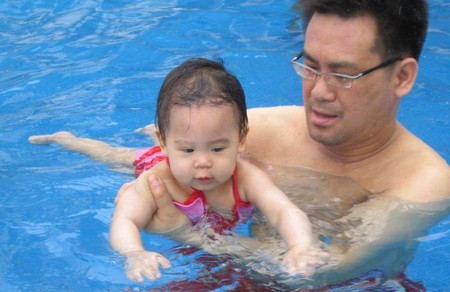Before commencing the arm movements, the teacher should demonstrate how to move one arm in a circle. When demonstrating, hold the arm stiffly straight, horizontally and in front, fingers pointed, palms down. Swing the arm down to the leg, sweep it back behind as far as it will go, then bring the arm up and over slowly without bending the elbow. Children should do this standing out of the water, moving one arm first, then the other. When they are moving their arms correctly, holding them straight, they can practice moving them continuously.
Why Should the Arms Be Straight?
The correct freestyle stroke is done by bending the elbows slightly over the water with the tips of the fingers touching the water first, followed by the firm but bent wrist. My many years of teaching experience, however, have taught me that if one shows a child a slightly bent elbow they will overemphasize the movement. Their arms enter the water at too sharp an angle, about 45 degrees, which cuts the freestyle stroke in half. By showing a straight-arm entry, they get the feeling of stretching out in front, reaching down into the water, and thus achieving an economical stroke technique. As they are progressing they loosen up and, without anybody telling them, they begin to bend their arms naturally, so that they finish up swimming a relaxed and correct freestyle stroke. If a child, by some miracle, looks as if he is going to do this, for goodness’ sake don’t tell him to keep his arms straight (but, believe me, this doesn’t happen often.)

After showing them how to move their arms, tell them, “Take a deep breath, put your face in the water, and swim slowly to me, moving your arms.” Have them do this a few times before you start correcting them. Look under the water and watch their arms and how they pull.
If the child doesn’t pull down on the center line of his body, correct this by showing him the angle he is using, then show him the correct angle. Tell him to open his eyes under the water and watch his hands going down. He can see for himself what you are talking about—whether his arms are going down straight or slipping out to the side. The teacher can say, “If you pull out to the side, you are pushing the water away from you, but if you pull your arms straight down, you will push the water underneath you.” (By the way, it’s not true that the fingers should be pressed tightly against one another and that it is a capital sin to have the fingers open.) Watch carefully that nobody swims with a bent elbow.